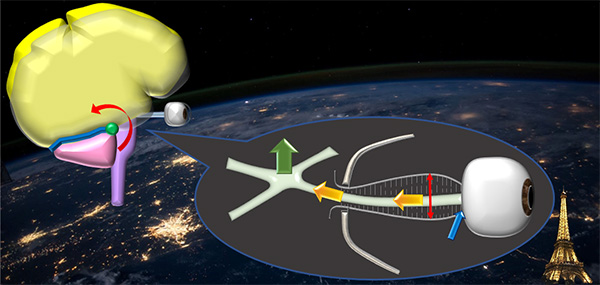An upward shift of the brain in zero-g
Neil Armstrong walking on the moon remains one of humankind’s greatest accomplishments. For the many not alive to see the moment, there is anticipation of the next Neil Armstrong walking on Mars. While rocket scientists are building spaceships that can travel this great distance, medical researchers are diligently examining the effects long-term space travel has on the human body.
A new study by scientists at Kyoto University's Graduate School of Engineering, Lariboisière Hospital in France, and Osaka University explains in JAMA Ophthalmology how changes to the optic nerve sheath, which helps the optic nerve transmit information from the eye to the brain, becomes deformed in space due to an upward shift of the brain.
Too much time in space changes bone density, reduces muscle, and it turns out even change the size of your eyes. Changes to the eyes, suggests not only altered vision, but also changes in the brain.
“What causes changes in the eye is controversial. One theory is cerebral spinal fluid pressure,” says first author Ari Shinojima.
Cerebral spinal fluid separates the brain from the skull. It gives the brain buoyancy, protecting the brain from sudden head trauma. Changes in cerebral spinal fluid pressure could cause permanent damage to the brain by either limiting blood supply or squeezing the brain itself.
Cerebral spinal fluid can be measured by a spinal tap, a painful process that requires the presence of exceptionally trained doctors. Simply put, a spinal tap is not an option in space. Shinojima spoke with Itsuhiro Kakeya, about a way to examine cerebral spinal fluid pressure based on changes to the eye.
Kakeya modelled the optic nerve sheath as a cylinder and then incorporated it into past anatomical studies. The model connects cerebral spinal fluid pressure to the radius of the optical nerve sheath, which can be measured in space easily with ultrasonography.
“The model allowed us to apply material mechanics theory,” says Kakeya, which he used to estimate the fluid pressure.
After discussion with Satoru Tada at Osaka University, the researchers concluded from the model that changes in the eye were primarily the result of the brain's upward shift -- an effect commonly seen in astronauts -- and not severe changes in cerebral spinal fluid pressure.
Authors note that their findings should encourage research on how to prevent other physiological changes in space.

Flattening of the eyeball (blue arrow) and enlargement of the optic nerve sheath (vertical red arrow) was found in the MRIs of astronauts returning from space. The authors report that the condition is caused by the retraction and deformation of the optic nerve (yellow and red arrow respectively) following the upward movement of the optic cross (green arrow) by gravity (Kyoto University / Kakeya Lab)
Paper information
【DOI】 https://doi.org/10.1001/jamaophthalmol.2018.2635
Ari Shinojima, Itsuhiro Kakeya, Satoru Tada (2018). Association of Space Flight With Problems of the Brain and Eyes. JAMA Ophthalmology, 136(9), 1075-1076.





